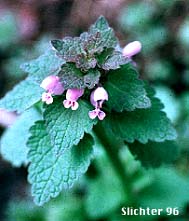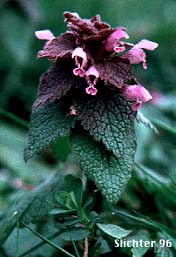 Characteristics:
Characteristics:
Red dead-nettle is an annual with one to several stems ascending or spreading from the base up to 10-40 cm long. The stems may be simple or often branched from the base. The herbage is inconspicuously hairy or nearly glabrous. The leaves are opposite on the square (cross-section) stems. 1-3 pairs of larger leaves are found on the lower stems, while the bulk of the leaves are found crowded near the apex of the stem (See photo above and at right.). Individual leaves are heart-shaped with rounded teeth on the margins and measure from 1.5-3 cm long. The venation is prominent, with raised areas between the veins. The lower leaves are long-petiolate while those of the upper stem have short petioles. The uppermost leaves are also marked with purple.
The inflorescence is a tightly spaced series of whorls of pink or lavender flowers in the upper leaf axils. The inflorescence resembles a 4-sided pagoda, with the pinkish flowers partially hidden by the larger leaves above them. The calyx is 5-8 mm long and bell-shaped, with hairy calyx lobes as long or longer than the tube. The corolla is pink-purple and from 10-15 mm long. The upper lip is hooded, while the lower lip is prominent and two-lobed.
Red dead-nettle may be found in moist, disturbed places, including yards, gardens and fields.
Red dead-nettle may be found across much of North America. It originated in Eurasia.
All parts of red dead-nettle are edible, and may be used in salads. Plants should be washed before use, and care must be taken to collect plants which have not been exposed to herbicides or insecticides. Poultices of the fresh plant may help reduce swelling and speed the healing of stings, small wounds, and minor burns. The leaves were used as a tea to reduce both internal or external bleeding, and to relieve diarrhea.
